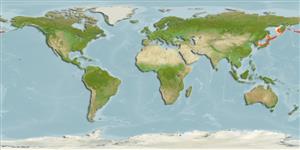Environment: milieu / climate zone / depth range / distribution range
Écologie
marin démersal; profondeur 126 - 700 m (Ref. 50610). Temperate
North Pacific: Sea of Okhotsk.
Taille / Poids / Âge
Maturity: Lm ? range ? - ? cm
Max length : 7.6 cm SL mâle / non sexé; (Ref. 34722)
Life cycle and mating behavior
Maturité | Reproduction | Frai | Œufs | Fécondité | Larves
Eschmeyer, W.N. (ed.), 2001. Catalog of fishes. Updated database version of December 2001. Catalog databases as made available to FishBase in December 2001. (Ref. 40966)
Statut dans la liste rouge de l'IUCN (Ref. 130435: Version 2024-2)
Menace pour l'homme
Harmless
Utilisations par l'homme
Outils
Articles particuliers
Télécharger en XML
Sources Internet
Estimates based on models
Preferred temperature (Ref.
123201): 0.6 - 3.8, mean 1.5 °C (based on 72 cells).
Phylogenetic diversity index (Ref.
82804): PD
50 = 0.7500 [Uniqueness, from 0.5 = low to 2.0 = high].
Bayesian length-weight: a=0.00389 (0.00180 - 0.00842), b=3.12 (2.94 - 3.30), in cm total length, based on all LWR estimates for this body shape (Ref.
93245).
Niveau trophique (Ref.
69278): 3.3 ±0.3 se; based on size and trophs of closest relatives
Fishing Vulnerability (Ref.
59153): Low vulnerability (10 of 100).
